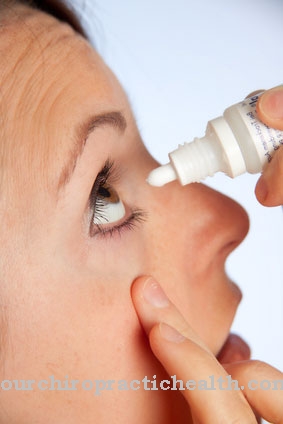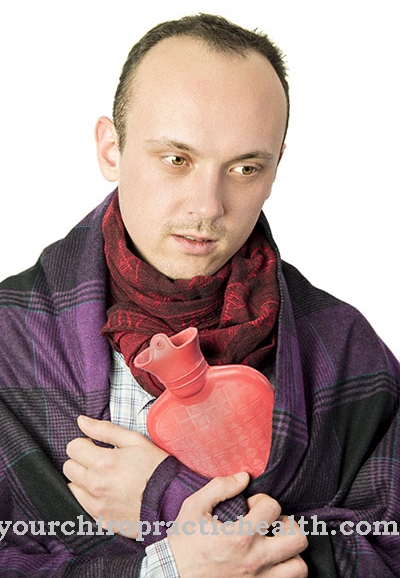The Altitude retinopathy is a haemorrhage of the retina and corresponds to a reaction to the falling oxygen partial pressure in the breath. The disease is considered a mountaineering disease and can be a sign of altitude sickness. Immediate descent to lower altitudes is required for therapy.
What is altitude retinopathy?

© PrettyVectors - stock.adobe.com
Retinopathy is a retinal disease that is associated with vascular changes in the retina and can result in permanent retinal damage and impairment of the visual field. The causes of retinopathy can range from swelling to diabetes. The so-called Altitude retinopathy is a subtype of the retinopathy group of diseases, which is causally related to natural changes in the air we breathe at high altitudes.
This form of retinopathy was first described in 1969. Singh and colleagues are considered to be the first to describe it. Since the first reports, numerous cases of altitude retinopathy have been documented, mainly affecting mountaineers and other alpine athletes. The presence of pronounced retinopathy can be the symptom of altitude sickness, which can result in life-threatening brain edema.
causes
At high altitudes above sea level, the partial pressure of oxygen in the air we breathe falls. The vessels of the retina react to the falling oxygen partial pressure. The blood retinal barrier collapses: high altitude retinopathy sets in. The main causative factors are the speed of ascent, your own constitution, the severity of the physical strain and the altitude you reached in the end.
Altitude retinopathies are common symptoms from heights of 5000 meters above sea level. From 7000 meters they affect almost everyone. The gender does not matter. Since the bleeding mostly occurs in the areas of the peripheral visual field, mountaineers often do not notice it subjectively.
Nonetheless, altitude retinopathy can correlate with vascular changes in the brain and thus be a sign of altitude sickness. The relationship between the lung and brain edema of altitude sickness and severe altitude retinopathies has not yet been conclusively established.
Symptoms, ailments & signs
Changes in the retina are seen in patients with high altitude retinopathy. These changes manifest themselves in the form of hemorrhages, which are often exclusively in the peripheral visual field. As soon as the bleeding is in the central field of vision, the patient perceives the changes subjectively as poor eyesight. The vascular changes can be accompanied by edema in the papilla or optic nerve area.
Especially when the optic nerve is involved, the poor eyesight increases, as the visual information can no longer pass into the brain undisturbed. When the macular area is involved in height retinopathy, patients notice the changes immediately and with great intensity. A drop in visual acuity to almost zero is a conceivable symptom of this phenomenon.
If the retinopathy is associated with altitude sickness, it is accompanied by changes in the cerebral vessels and can be associated with severe headache, vomiting, dizziness, loss of appetite, shortness of breath and tinnitus or general weakness. As a sign of altitude sickness, altitude retinopathy can lead to cerebral or pulmonary edema which, if left untreated, can be fatal.
Diagnosis & course of disease
The suspected diagnosis of altitude retinopathy is usually not made by the doctor immediately after it occurs, but by companions of the person concerned. Significant for this are visible changes in the retina, which the patient describes as reducing vision. Only after the descent is the presence of retinopathy confirmed by doctors or emergency doctors.
In most cases, the diagnosis is confirmed by ophthalmological examinations and finally leads to an examination of altitude sickness. The prognosis for patients with altitude retinopathy depends largely on whether the appearance is a sign of altitude sickness. Altitude sickness has a much less favorable prognosis than isolated retinopathies. The time of diagnosis also affects the prognosis.
Complications
In most cases, altitude retinopathy does not have any particular or serious complications. The patient can counteract the disease relatively easily and thus easily limit the symptoms. Usually there is bleeding on the retina of the eye. This bleeding causes visual problems in the patient.
These can also lead to blurred vision or double vision and continue to worsen the general condition of the person concerned. It is not uncommon for headaches, nausea and vomiting to continue. The falling blood pressure can also cause dizziness, which in the worst case can lead to a loss of consciousness. The person affected can injure himself if he falls. In some cases there is also shortness of breath and thus panic attacks or sweating.
In general, the patient's resilience decreases. Altitude retinopathy is treated by descending to a lower altitude. As a rule, there are no particular complications. In acute cases, drugs can also be used. Furthermore, the patient must rest and take it easy. In general, it is impossible to predict whether further ascent is possible.
When should you go to the doctor?
If changes in the retina are noticed, a doctor should be consulted immediately. Altitude retinopathy requires rapid diagnosis and treatment, because serious complications can arise if the disease progresses. That is why a doctor should be consulted at the first abnormality. People who suddenly experience a decrease in vision should consult an ophthalmologist. A visit to the doctor is indicated at the latest when accompanying symptoms such as headache, shortness of breath and nausea and vomiting occur. A general feeling of weakness also requires medical clarification.
If the retinopathy occurs in connection with altitude sickness, a hospital should be visited immediately. If left untreated, the disease can cause life-threatening edema of the brain or lungs. Externally, altitude retinopathy can be recognized primarily by the visible bleeding into the retina. The eye may also be swollen or watery. People who are at an altitude of over 5,000 meters above sea level are particularly prone to developing high altitude retinopathy. Mountaineers, hikers and co. Should immediately start the descent with the warning signs mentioned and consult a doctor.
Doctors & therapists in your area
Therapy & Treatment
The patient takes the first steps in the treatment of altitude retinopathy himself. Further ascent to even greater heights is absolutely contraindicated. The affected person should aim for the descent as soon as possible. If he is unable to do so because he also suffers from the symptoms of altitude sickness, contact with the mountain rescue service or the patient being transported down by his companion is indicated.
If you have mild to moderate symptoms of altitude sickness, we recommend that you take a break for at least one day. Headaches can be treated with a non-steroidal anti-inflammatory drug such as ibuprofen. Antiemetics can be given against nausea. Acetazolamide helps with acclimatization. These measures are primarily intended to stabilize the patient and enable him to descend.
If symptoms are severe, descent should be done immediately. When possible, patients are given oxygen and dexamethasone to prevent cerebral edema from developing. Regardless of whether the altitude retinopathy was a sign of altitude sickness or not, the patient should be examined by a doctor when they arrive below. In normal cases, an isolated retinopathy regresses as soon as the person concerned has left the causal area.
You can find your medication here
➔ Medicines for eye infectionsprevention
Altitude retinopathy can possibly be prevented by the same prophylaxis as altitude sickness. A slow ascent is desirable. In a few days, the body only adapts to a certain extent to the changes in altitude. This adjustment corresponds to the production of red blood cells and is considered acclimatization.
For mountain tours over 4500 meters, the mountaineer should spend at least a week at an altitude of 2000 meters and undertake day tours in higher areas. During the ascent, a break every 500 meters in altitude can prevent altitude sickness.
Aftercare
Follow-up care for high altitude retinopathy primarily relates to precautionary measures. In order to protect themselves from the complaints of greater height differences, those affected can take a height measuring device with them and train their conscious self-observation. In this way, problems with the retina can be identified in good time.
Mountaineers who suffer from this disease usually already know from experience at which altitude it becomes difficult for them. Then a return to the previous position or height is advisable so that the symptoms subside. Rapid differences in altitude or short-term mountain tours are not recommended. It is better to prepare intensively and climb gradually so that the body gets used to the current altitude.
If the symptoms occur more frequently, those affected should see a doctor. The first sign is impaired vision, then other problems such as headaches and dizziness can occur. However, if the companions have all the necessary information about the altitude sickness, it is still possible to take part in mountain tours; provided that those affected take their time.
After the symptoms and the descent, the patients should rest first. This reduces the risk of loss of consciousness, which can lead to accidents and injuries. In such a recovery break, the feeling of panic also disappears.
You can do that yourself
In the case of height retinopathy, it is advisable to always carry a height measuring device with you. Modern automobiles have integrated height measurement into their on-board function. It is also advisable to use an additional mobile device to attach it to clothing.
Those affected can often assess the altitude at which their health problems occur based on their experience. These should only be approached slowly and with several pauses. At the first signs of altitude retinopathy, it is advisable to change your position and return to a lower location.
If the symptoms increase, a doctor's visit is necessary in order not to take any further risks. Sudden differences in altitude should be avoided. A short-term mountain hike should generally be avoided. If there is good preparation and planning for an ascent, many people affected can also go to places in higher altitudes despite the illness. Several days or weeks should be planned for this so that the organism can slowly get used to the existing altitude. During this time, a gradual change in altitude is possible and tolerable for the body. To avoid health risks, the planning should be discussed with a doctor in advance. Accompanying persons must be informed about the illness and good self-reflection is necessary during the change in altitude.




.jpg)
.jpg)


















.jpg)



